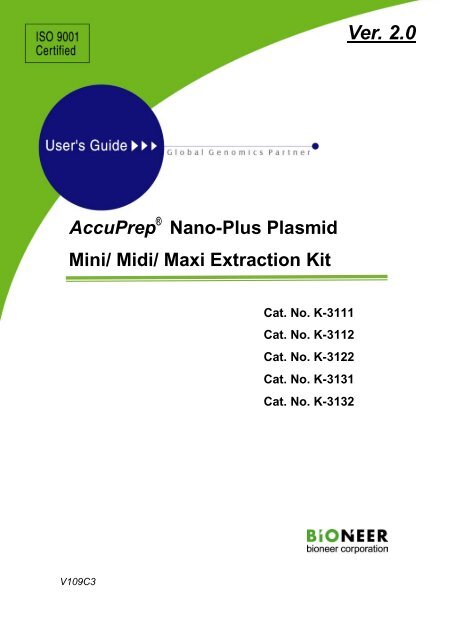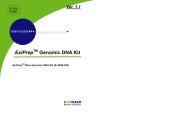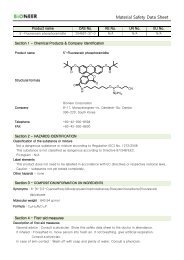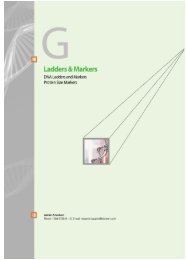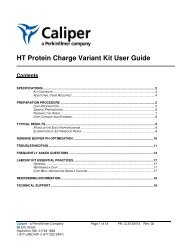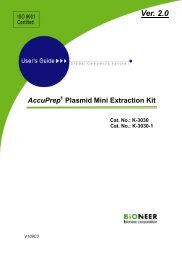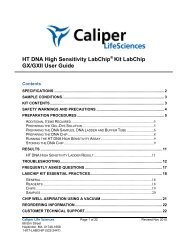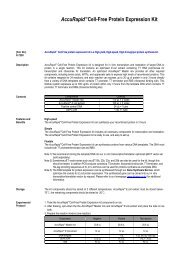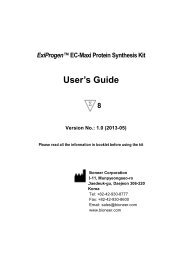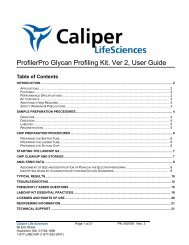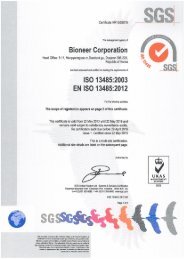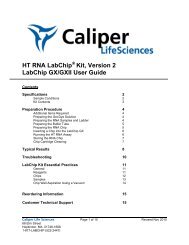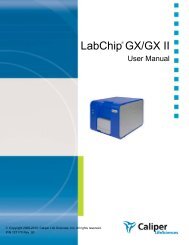Nano-Plus Plasmid Mini/ Midi/ Maxi Extraction Kit
Nano-Plus Plasmid Mini/ Midi/ Maxi Extraction Kit
Nano-Plus Plasmid Mini/ Midi/ Maxi Extraction Kit
You also want an ePaper? Increase the reach of your titles
YUMPU automatically turns print PDFs into web optimized ePapers that Google loves.
Ver. 2.0AccuPrep ® <strong>Nano</strong>-<strong>Plus</strong> <strong>Plasmid</strong><strong>Mini</strong>/ <strong>Midi</strong>/ <strong>Maxi</strong> <strong>Extraction</strong> <strong>Kit</strong>Cat. No. K-3111Cat. No. K-3112Cat. No. K-3122Cat. No. K-3131Cat. No. K-3132V109C3
Safety Warnings and Precautions.AccuPrep R <strong>Nano</strong>-<strong>Plus</strong> <strong>Plasmid</strong> <strong>Extraction</strong> <strong>Kit</strong> is developed and sold forresearch purposes only. It is not recommended for human or animaldiagnostic use, unless cleared for such purposes by the appropriateregulatory authorities in the country of use.Wear appropriate protection when handling any irritant or harmfulreagents. The use of a laboratory coat, protective gloves and safetygoggles are highly recommended. For more information please consultthe appropriate Material Safety Data Sheets (MSDS).The Neutralization Buffer contains a chaotrophic salt and should behandled with care. Chaotrophic salts form highly reactive compoundswhen combined with bleach. Thus great care must be taken to properlydispose of this solution.Warranty and LiabilityAll BIONEER products undergo extensive Quality Control testing andvalidation. BIONEER guarantees quality during the warranty period asspecified, when following the appropriate protocol as supplied with theproduct. It is the responsibility of the purchaser to determine thesuitability of the product for its particular use. Liability is conditional uponthe customer providing full details of the problem to BIONEER within 30days.Quality Management System ISO 9001 CertifiedEvery aspect of Bioneer’s quality management system from productdevelopment to production to quality assurance and supplierqualification meets or exceeds the world-class quality standards.TrademarksAccuPrep is trademark of Bioneer Corporation in Korea.Copyright 2007 by Bioneer Corporation. All rights reservedV109C3
AccuPrep ® <strong>Nano</strong>-<strong>Plus</strong><strong>Plasmid</strong> <strong>Mini</strong> <strong>Extraction</strong> <strong>Kit</strong>(K-3111, K-3112)AccuPrep ® <strong>Nano</strong>-<strong>Plus</strong><strong>Plasmid</strong> <strong>Midi</strong> <strong>Extraction</strong> <strong>Kit</strong>(K-3122)AccuPrep ® <strong>Nano</strong>-<strong>Plus</strong><strong>Plasmid</strong> <strong>Maxi</strong> <strong>Extraction</strong> <strong>Kit</strong>(K-3131, K-3132)AccuCap(KC-1000)
CONTENTSI. DESCRIPTION .............................................................. 1II. KIT COMPONENTS ..................................................... 2III. BEFORE YOU BEGIN ................................................. 3IV. PROCEDURE ............................................................. 4V. EXPERIMENTAL PROTOCOL FOR MINI PREP........ 5VI. EXPERIMENTAL PROTOCOL FOR MIDI PREP ...... 8VII. EXPERIMENTAL PROTOCOL FOR MAXI PREP .. 13VIII. TROUBLESHOOTING ............................................ 18IX. REFERENCES .......................................................... 20
AccuPrep ® <strong>Nano</strong>-<strong>Plus</strong> <strong>Plasmid</strong> <strong>Extraction</strong> <strong>Kit</strong>Technical ManualI. DescriptionThe AccuPrep ® <strong>Nano</strong>-<strong>Plus</strong> <strong>Plasmid</strong> <strong>Mini</strong>, <strong>Midi</strong> and <strong>Maxi</strong> <strong>Extraction</strong><strong>Kit</strong> was developed for the extraction of highly purified plasmid DNAfrom cultured bacterial cells within 10 min.(mini), 40 min.(<strong>Midi</strong>) or60 min.(<strong>Maxi</strong>) The overall principle combines modified alkalinelysis method(Birnboim et al, 1979) and Bioneer’s novel <strong>Nano</strong>-Technology(Patent pending). Collected cells are re-suspended inResuspension Buffer contains <strong>Nano</strong>-solution. Following theaddition of Lysis Buffer and Neutralization Buffer to the lysate, thechromosomal DNA and cell debris will be forms an insolubleaggregate. Bioneer’s <strong>Nano</strong>-solution effectively bound to the proteinaggregate and increase the total weight of the complex. Theinsoluble protein aggregate is removed following centrifugationand transfer the clear lysate to the DNA binding filter tube. Thecleared lysate contains a chaotropic salt originating fromNeutralization Buffer which helps the binding of the plasmid DNAon the membrane surface. The DNA binding filter which is packedwith silica based membrane has enough surface area to bind up to20 g (mini), 100 g (<strong>Midi</strong>) or 500 g (<strong>Maxi</strong>) of plasmid DNA. Anysalts and precipitates are eliminated by addition of the WashingBuffer. Finally, highly purified plasmid DNA can be eluted withElution Buffer or Nuclease free autoclaved distilled water(notprovided).1
II. <strong>Kit</strong> Components<strong>Mini</strong>Cat. No K-3111 K-3112Buffer 1 60 ml 15 mlBuffer 2 60 ml 15 mlBuffer 3 80 ml 20 mlBuffer D 75 ml 18 mlBuffer 4 2×16 ml 2×4 mlBuffer 5 24 ml 6 mlRNase A powder 6 mg 1.5 mgDNA binding column tube 200 ea 50 eaUser’s Guide 1 ea 1 eaOne Page Protocol 1 ea 1 ea<strong>Midi</strong><strong>Maxi</strong>Cat. No K-3122 K-3131 K-3132Buffer 1 90 ml 240 ml 96 mlBuffer 2 90 ml 240 ml 96 mlBuffer 3 90 ml 240 ml 96 mlBuffer 4 3×40 ml 3×80 ml 3×30 mlBuffer 5 50 ml 50 ml 20 mlRNase A powder 9 mg 24 mg 9.6 mgClearing Syringe Filter (10 ml) 25 ea - -Clearing Syringe Filter (30 ml) - 25 ea 10 eaDNA Binding Filter Tubes (<strong>Midi</strong>) 25 ea - -DNA Binding Filter Tubes (<strong>Maxi</strong>) - 25 ea 10 eaUser’s Guide 1 ea 1 ea 1 eaOne Page Protocol 1 ea 1 ea 1 ea※ Buffer 3 and 4 contains chaotropic salt and should be handled withcare. Chaotrophic salts can makes highly reactive compounds whenmixed with disinfecting agent such as bleach.※ All buffers and DNA binding columns can be stored under room temp.But, Buffer 1 must stored at 4℃ after addition of RNase A powder.2
III. Before You BeginBefore you start your prep, please check the followings.1. Chemicals- Did you add RNase A powder to Buffer 1 and completely dissolve it ?- Did you add absolute EtOH to Buffer D as described below ?- Did you add absolute EtOH to Buffer 4 as described below ?Cat. No. K-3111 K-3112Buffer D 75 ml 18 mlAbsolute EtOH 45 ml 10.8 mlTotal 120 ml 28.8 mlCat. No. K-3111 K-3112 K-3122 K-3131 K-3132Buffer 4 16 ml 4 ml 40 ml 80 ml 30 mlAbsolute EtOH 64 ml 16 ml 160 ml 320 ml 120 mlTotal 80 ml 20 ml 200 ml 400 ml 150 ml2. Equipments- High speed refrigerated centrifuge (capable of ≥12,000 rpm, 4℃, e.g.,Beckman Avanti ® J Series, Sorvall ® RC-5B <strong>Plus</strong>, Hanil Supra series)- Swing Bucket rotor type Table-top centrifuge (capable of ≥3,000 rpm,e.g., Beckman Allegra ® X-12 Series, Sorvall Legend Mach 1.6/RTabletop, Hanil Union 32 R <strong>Plus</strong>)- Air-pressure system (capable of at least 40 psi, 2.81kg/cm 2 , 2.76 bar)or Oil-less(or Oil free) Air pump(or compressor)Are you ready to prep your <strong>Plasmid</strong> DNA?3
IV. Procedure- AccuPrep ® <strong>Nano</strong>-<strong>Plus</strong> <strong>Plasmid</strong> <strong>Mini</strong> <strong>Extraction</strong> <strong>Kit</strong>- AccuPrep ® <strong>Nano</strong>-<strong>Plus</strong> <strong>Plasmid</strong> <strong>Midi</strong> & <strong>Maxi</strong> <strong>Extraction</strong> <strong>Kit</strong>4
V. Experimental Protocol for <strong>Mini</strong> Prep.■ E.coli cell preparation1. Pick up a single colony from fresh cultured LB(Luria-Bertani) agar plate(contains antibiotics) or yourestablished media and inoculate the cell into the 1-5 mlof fresh LB liquid media (contains antibiotics) or yourestablished media at 37℃ with shaking for 12-16 hr.Do not over-growth your E.coli cell. It will decrease theproductivity because of the cell death and inefficient lysis.For high copy number plasmid DNA : 1~5ml of E.coli cellsFor low copy number plasmid DNA : 1~10ml of E.coli cells2. Collect the E.coli cells by centrifugation at >8,000 rpmfor 2 min. or >3,000 rpm for 5 min. And completelyremove of the media by pipetting.■ Cleared lysate preparation1. Add 250 μl of Buffer 1 to the collected cells andcompletely resuspend by vortexing or pipetting.Complete resuspension will make high lysis efficiency.Buffer 1 contains <strong>Nano</strong>-particle, please shake well beforeuse.2. Add 250 μl of Buffer 2 and mix by inverting the tube 3-4 times gently.Avoid vortex! Vortexing may cause shearing of genomicDNA. It is important to invert gently.5
3. Add 350 μl of Buffer 3 and immediately mix byinverting the tube 3-4 times, gently.Genomic DNA and cell debris will form an insolublecomplex. Again, be cautions not to shear genomic DNA.4. Centrifugation the tube at 13,000 rpm, 4℃ for 1 min.(>16,600 ×g) in a micro-centrifuge.After centrifugation, white protein aggregate and <strong>Nano</strong>particlecomplex will appear at the bottom of the tube. If yourcentrifuge is not enough to get a cleared lysate, pleasecentrifuge again.■ <strong>Plasmid</strong> DNA Purification5. Transfer the cleared lysate to the DNA binding columntube and centrifuge at 13,000 rpm for 1 min. Pour offthe flow-through and re-assemble the DNA bindingfilter column with the 2.0 ml collection tube.6. (Optional) Add 500 μl of Buffer D and wait for 5 min.and centrifuge at 13,000 rpm for 1 min. Pour off theflow-through and re-assemble the DNA binding filtercolumn with the 2.0 ml collection tube.This step is required if you are using an endA + strainswhich has a high endonuclease activity. BL21, CJ236,HB101, JM83, JM 101, JM110, LE392, NM series strains,PR series strains, Q358, PR1, TB1, TG1, Y10 seriesstrains, BMH71-18 and ES1301 are endA + strains, thusthey produce highly active endonucleases that candegrade plasmids. Denaturation step is not required for theDH5, XL1-Blue, BJ5183, DH1, DH20, DH21, JM103,JM105, JM106, JM107, JM108, JM109, MM294, SK1590,SK1592, SK2267, SRB and XLO strains.6
7. Add 700 μl of Buffer 4 to the DNA binding columntube and centrifuge at 13,000 rpm for 1 min. Pour offthe flow-through and re-assemble the DNA bindingfilter column with the 2.0 ml collection tube.This removes salts and soluble debris. The amount ofplasmid washed away in 80 % ethanol is negligible.8. Dry by additional centrifugation at 13,000 rpm for 1 min. toremove the residual ethanol.9. Transfer the DNA binding filter column to the new 1.5ml microcentrifuge tube (not provided).10. Add 50-100 μl of Buffer 5 to the DNA binding filtercolumn, and wait for at least 1 min. for elution.If you want to get a more concentrated solution of plasmid,a smaller volume is appropriate, but total yield may bereduced. If the plasmid is low copy or larger than 10 kb, theyield of plasmid may not be sufficient. Pre-warmed (about60 ℃) elution buffer will improve efficiency of elution.11. Elute the plasmid DNA by centrifugation at 13,000 rpmfor 1 min.If you want more quantity, elute the sample twice and use afterconcentrating process.7
VI. Experimental Protocol for <strong>Midi</strong> prep.■ E.coli cell preparation1. Pick up a single colony from fresh cultured LB(Luria-Bertani) agar plate(contains antibiotics) or yourestablished media and inoculate the cell into the 5 ml offresh LB liquid media (contains antibiotics) or yourestablished media at 37℃ with shaking.2. After 12-16 hr, take 50 ul of cultured cell and reinoculatethe cells into the 25 ~ 50 ml of fresh LB liquidmedia (contains antibiotics) or your established mediaat 37℃ with shaking for 12 - 16 hr.■ Cleared Lysate Preparation(This step needs high speed refrigerated centrifuge, e. g.,Beckman Avanti ® J series, Sorvall ® RC-5B <strong>Plus</strong>, Hanil Supraseries)1. Harvest 25 ml (high copy plasmid) or 50 ml (low copyplasmid) of cultured E. coli cells by centrifugation at6,000 rpm, 4℃ for 10 min. or 3,500 rpm, 4℃ for 15 min.and completely remove the media.2. Add 3 ml of Buffer 1 to the collected cells andcompletely resuspend by vortexing or pipetting.Complete resuspension will make high lysis efficiency.Buffer 1 contains <strong>Nano</strong>-particle, please shake well beforeuse.8
3. Add 3 ml of Buffer 2 and mix by inverting the tube 5-7times gently, and incubate the centrifuge tube at roomtemp. for 5 min.Avoid vortexing! Vortexing may cause shearing of genomicDNA. It is important to invert gently.4. Add 3 ml of Buffer 3 and immediately mix by invertingthe tube 5-7 times gently, and incubate the centrifugetube on ice for 5 min.Genomic DNA and cell debris will form a white mass.Again, be cautious not to shear genomic DNA.5. Centrifuge the tube at 13,000 rpm, 4℃ for 5 min.After centrifugation, white protein aggregate will appear.6. Transfer the lysate to the Clearing Syringe Filter.Do not insert the plunger into Clearing Syringe Filter beforetransferring the cleared lysate. And place the nozzle of theClearing Syringe Filter over the mouth of the DNA bindingfilter tube.7. Insert the plunger into the Clearing Syringe Filtercarefully, and collect the filtrate in the DNA binding filtertube.■ <strong>Plasmid</strong> DNA Purification (Spin Method)(This method needs a swing bucket rotor type centrifuge,e.g., Allegra ® X-12 Series Sorvall Mach 1.6/R Tabletop,Hanil 32R series)8. Centrifuge the DNA binding filter tube at 3,500 rpm,room temp. for 3 min.9
9. Pour off the flow-through and re-assemble the DNAbinding filter with the 50 ml test tube.10. Add 10 ml of Buffer 4 to the DNA binding filter tubeand centrifuge at 3,500 rpm, room temp. for 3 min.11. Pour off the flow-through and re-assemble the DNAbinding filter with the 50 ml test tube.This step removes salts and soluble debris. The amount ofplasmid washed away in 80 % ethanol is negligible.12. Repeat Step 10. and 11.13. Dry the DNA binding filter by additional centrifuge at 3,500rpm, room temp. for 5 min. to remove the residual ethanol.14. Transfer the DNA binding filter to the new 50 ml testtube (not provided).15. Add 1 ml of Buffer 5 to center of the DNA binding filter,and wait for at least 5 min. for elution.If, more concentrated solution of plasmid is required, asmaller volume can be used, but total yield may bereduced. Also if the plasmid is low copy or larger than 10kb, the yield of plasmid may not be sufficient. Pre-warmed(about 60℃) elution buffer will also improve efficiency ofelution.16. Elute the plasmid DNA by centrifuge at 3,500 rpm, roomtemp. for 5 min.If you want more quantity, elute the sample twice and useafter concentrating process.10
■ <strong>Plasmid</strong> DNA Purification (Air-Pressure Method)(This method needs at least 40 psi, 2.81kg/cm 2 or 2.76 barof air-pressure system or air pump, air compressor)8. Assemble the AccuCap(not provided, Cat. No. KC-1000)to the DNA binding filter and locate above on the wastebottle (not provided).9. Turn on the air pressure system until completely passthe filtrate, carefully.10. Open the AccuCap and add 10 ml of Buffer 4 to theDNA binding filter and re-assemble the AccuCap withDNA binding filter.11. Turn on the air pressure system until completely passthe washing buffer, carefully.12. Repeat Step 10. and 11.This step removes of the salts and soluble debris. Theamount of plasmid washed away in 80 % ethanol isnegligible.13. Dry the DNA binding filter by additional air injection for 5min. to remove the residual ethanol.14. Open the AccuCap and add 1 ml of Buffer 5 to centerof the DNA binding filter, and wait for 5 min. for elution.If you want to get a more concentrated solution of plasmid, asmaller volume is appropriate, but total yield may bereduced. If the plasmid is low copy or larger than 10 kb,the yield of plasmid may not be sufficient. Pre-warmed(about 60℃) elution buffer will improve efficiency of elution.11
15. Re-assemble the AccuCap with DNA binding filter andlocate the nozzle of the DNA binding filter at inner sideof the new 50 ml test tube (not provided).16. Elute the plasmid DNA by air injection to the DNAbinding filter until completely pass the buffer.Warning! Sometimes <strong>Plasmid</strong> DNA solution spattered outside of the 50 ml test tube. Carefully collect the purified<strong>Plasmid</strong> DNA into the 50 ml test tube.12
VII. Experimental Protocol for <strong>Maxi</strong> prep.■ E.coli cell preparation1. Pick up a single colony from fresh cultured LB(Luria-Bertani) agar plate(contains antibiotics) or yourestablished media and inoculate the cell into the 5 ml offresh LB liquid media (contains antibiotics) or yourestablished media at 37℃ with shaking.2. After 12-16 hr, take 100 ul of cultured cell and reinoculatethe cells into the 100 ~ 150 ml of fresh LBliquid media (contains antibiotics) or your establishedmedia at 37℃ with shaking for 12 - 16 hr.■ Cleared Lysate Preparation(This step needs high speed refrigerated centrifuge, e. g.,Beckman Avanti ® J series, Sorvall ® RC-5B <strong>Plus</strong>, Hanil Supraseries)1. Harvest 100 ml (high copy plasmid) or 150 ml (low copyplasmid) of cultured E. coli cells by centrifugation at6,000 rpm, 4℃ for 15 min. or 3,500 rpm, 4℃ for 20 min.and completely remove the media.2. Add 9 ml of Buffer 1 to the collected cells andcompletely resuspend by vortexing or pipetting.Complete resuspension will make high lysis efficiency.Buffer 1 contains <strong>Nano</strong>-particle, please shake well beforeuse.13
3. Add 9 ml of Buffer 2 and mix by inverting the tube 5-7times gently, and incubate the centrifuge tube at roomtemp. for 5 min.Avoid vortexing! Vortexing may cause shearing of genomicDNA. It is important to invert gently.4. Add 9 ml of Buffer 3 and immediately mix by invertingthe tube 5-7 times gently, and incubate the centrifugetube on ice for 10 min.Genomic DNA and cell debris will form a white mass.Again, be cautious not to shear genomic DNA.5. Centrifuge the tube at 13,000 rpm, 4℃ for 10 min.After centrifugation, white protein aggregate will appear.6. Transfer the lysate to the Clearing Syringe Filter.Do not insert the plunger into Clearing Syringe Filter beforetransferring the cleared lysate. And place the nozzle of theClearing Syringe Filter over the mouth of the DNA bindingfilter tube.7. Insert the plunger into the Clearing Syringe Filtercarefully, and collect the filtrate in the DNA binding filtertube.■ <strong>Plasmid</strong> DNA Purification (Spin Method)(This method needs a swing bucket rotor type centrifuge,e.g., Allegra ® X-12 Series Sorvall Mach 1.6/R Tabletop,Hanil 32R series)8. Centrifuge the DNA binding filter tube at 3,500 rpm,room temp. for 5 min.14
9. Pour off the flow-through and re-assemble the DNAbinding filter with the 50 ml test tube.10. Add 20 ml of Buffer 4 to the DNA binding filter tubeand centrifuge at 3,500 rpm, room temp. for 5 min.11. Pour off the flow-through and re-assemble the DNAbinding filter with the 50 ml test tube.This step removes salts and soluble debris. The amount ofplasmid washed away in 80 % ethanol is negligible.12. Repeat Step 10. and 11.13. Dry the DNA binding filter by additional centrifuge at 3,500rpm, room temp. for 5 min. to remove the residual ethanol.14. Transfer the DNA binding filter to the new 50 ml testtube (not provided).15. Add 1 ml of Buffer 5 to center of the DNA binding filter,and wait for at least 5 min. for elution.If, more concentrated solution of plasmid is required, asmaller volume can be used, but total yield may bereduced. Also if the plasmid is low copy or larger than 10kb, the yield of plasmid may not be sufficient. Pre-warmed(about 60℃) elution buffer will also improve efficiency ofelution.16. Elute the plasmid DNA by centrifuge at 3,500 rpm, roomtemp. for 5 min.If you want more quantity, elute the sample twice and useafter concentrating process.15
■ <strong>Plasmid</strong> DNA Purification (Air-Pressure Method)(This method needs at least 40 psi, 2.81kg/cm 2 or 2.76 barof air-pressure system or air pump, air compressor)8. Assemble the AccuCap(not provided, Cat. No. KC-1000)to the DNA binding filter and locate above on the wastebottle (not provided).9. Turn on the air pressure system until completely passthe filtrate, carefully.10. Open the AccuCap and add 20 ml of Buffer 4 to theDNA binding filter and re-assemble the AccuCap withDNA binding filter.11. Turn on the air pressure system until completely passthe washing buffer, carefully.12. Repeat Step 10. and 11.This step removes of the salts and soluble debris. Theamount of plasmid washed away in 80 % ethanol isnegligible.13. Dry the DNA binding filter by additional air injection for 5min. to remove the residual ethanol.14. Open the AccuCap and add 1 ml of Buffer 5 to centerof the DNA binding filter, and wait for 5 min. for elution.If you want to get a more concentrated solution of plasmid, asmaller volume is appropriate, but total yield may bereduced. If the plasmid is low copy or larger than 10 kb,the yield of plasmid may not be sufficient. Pre-warmed(about 60℃) elution buffer will improve efficiency of elution.16
15. Re-assemble the AccuCap with DNA binding filter andlocate the nozzle of the DNA binding filter at inner sideof the new 50 ml test tube (not provided).16. Elute the plasmid DNA by air injection to the DNAbinding filter until completely pass the buffer.Warning! Sometimes <strong>Plasmid</strong> DNA solution spattered outside of the 50 ml test tube. Carefully collect the purified<strong>Plasmid</strong> DNA into the 50 ml test tube.17
VIII. Troubleshooting1. Low yield of plasmid1) Did you harvest a sufficient amount of cells ? The yieldis dependent on the host strain type and an overload ofcells may decrease the yield.2) Did you completely resuspend the cells with Buffer 1 ?Incomplete resuspension decreases the efficiency of lysis.3) Is there precipitated salt in the Buffer 3 ? Vortex orshake well to re-dissolve the precipitant. An improperconcentration of the chaotrophic agent will decrease theyield. If it does not re-dissolve easily, warm it to 60 ℃.4) Has it been over 6 months since you added RNase Apowder? Low concentration of RNase A can result in alow yield of plasmid. After about 6 months, add moreRNase A, up to 100 g/l.2. Contamination of chromosomal DNA (The appearance ofunexpected bands following gel electrophoration).During neutralization step, samples should not be vortexor shaken vigorously. Also, the period of lysis should notbe longer than 5 min. Both can shear the chromosomalDNA. Handle the lysate gently!18
3. Sample floats upon loading in agarose gel.Sample contains alcohol. Floating is caused by leftoverethanol. You must always dry the column completelyby centrifugation and make sure that no droplet ishanging from the tip of the binding column.4. Too many background bands appear in sequencinganalysis.Did you check the endonuclease activity of your strain ofhost E. coli? HB101, JM series and normal wild-typehosts that have high endonuclease activity interrupt thesequencing reaction by degrading the plasmid. Werecommend using the EndA - strain instead of EndA +strain.5. Sample contains RNA.1) RNase activity is weakened. If it has been over 6 monthssince adding the RNase A powder to the Resuspension,the RNase A may not work properly. Add more RNase Apowder, up to 100 g/l.19
IX. References1. Boom, R. et al. (1990), J. Clin. Microbiol., 28, 495-5032. Carter, M.J. and Milton, I.D. (1993) Nucleic Acids Res.,21, 10443. Taylor, R. G., Walker, D. C. and Mclnnes, R. R. (1993)Nucleic Acids Res., 21, 1677-16784. Melzak, K. A. et al. (1996), J Colloid and Interface Sci.,181, 635-6445. Sambrook, J., Fritsch, E.F. and Maniatis, T. (1989)Molecular Cloning 2 nd Ed.20
Headquarters Seoul Office USA Bioneer, Inc. Order49-3,Munpyeong-dong,Daedeok-gu,Daejeon306-220,KoreaPhone:+82-42-936-8500Fax:+82-42-930-8600412, 1580, DMC Hi-tech industrycenter, Sangam-dong, Mapo-gu,Seoul, 121-835, Republic of KoreaPhone:+82-2-598-1094Fax:+82-2-598-10961000 Atlantic Avenue, Alameda, CA94501 USAToll free : 1-877-264-4300Fax : 1-510-865-0350E-mail:order.usa@bioneer.comDomestic only: 1588-9788E-mail: order@bioneer.co.krURL: www.bioneer.com


